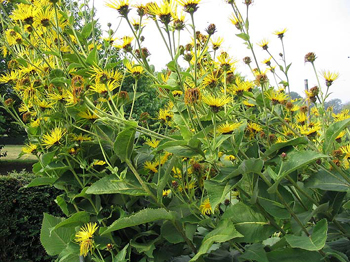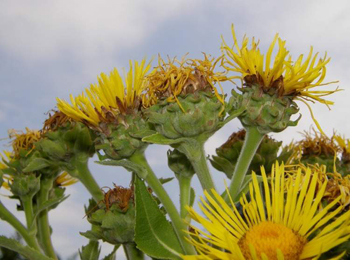Contents:
Common Names | Parts Usually Used | Plant(s) & Culture | Where Found | Medicinal Properties | Biochemical Information
Legends, Myths and Stories | Uses | Formulas or Dosages | How Sold | Warning | Bibliography
Scientific Names

- Inula helenium L.
- Inula britanica
- Inula Chinensis
- Compositae
- Composite family
Common Names
- Aunee
- Chin-ch’ien-hua
- Elfdock
- Elfwort
- Horse-elder
- Horseheal
- Hsuan-fu-hua
- Pushkaraula (Sanskrit name)
- Scabwort
- Velvet dock
- Xuan fu (Chinese name)
Parts Usually Used
Roots, leaves, flowers
Back to Top
Description of Plant(s) and Culture

Elecampane is a perennial plant 4-8 feet tall; the fibrous, top-shaped rootstock is brown outside and white inside. The stout, round stem is coarse and woolly, 3-6 feet high, and bears large, alternate, ovate, serrate, olive-colored leaves with white veins; tacky to the touch. The large, bright yellow flower heads 4 inches across, daisy-like, are solitary or grow in paniculate clusters from July to September. The fruit is a brown, quadrangular achene. The whole plant exudes a pungent odor similar to camphor; stalks have a bitter aromatic taste. This plant is similar in appearance to horseradish.
Back to Top
Where Found
Cultivated and also grows wild along roadsides and in fields, roadsides, and waste places, usually in sandy-moist soil, eastward from Minnesota and Missouri and northward from North Carolina. Elecampane is not a native of the United States, a European and Asian plant, but has been thoroughly naturalized, having come here with the earliest immigrants. Indigenous to North China, Mongolia, Manchuria, and Korea and various places in Japan.
Back to Top
Medicinal Properties
Anthelmintic, antispasmodic, analgesic, cholagogue, diuretic, diaphoretic, expectorant, stimulant, aromatic, astringent, tonic, carminative, antiseptic, alterative, deobstruent, laxative, antiemetic, stomachic, emmenagogue
Back to Top
Biochemical Information
Essential oil, bitter principles, resin, inulin, carbohydrate
Back to Top
Legends, Myths and Stories
Way back in Roman times, Pliny told of the fact that the use of elecampane would relieve indigestion.
Elecampane was one of the most important herbs to the Greeks and Romans. It was regarded as almost a cure-all for dropsy, digestive upsets, menstrual disorders and sciatica. The Anglo-Saxons used the herb as a tonic, for skin diseases, and leprosy. By the 19th century, it was used to treat skin disease, neuralgia, liver problems, and coughs. Today it is used almost exclusively for respiratory problems. In China, Inula japonica, also called elecampane, is used instead of I. helenium.
Back to Top
Uses
Elecampane tea (1/2 oz. to 1 pint water) is much used to quiet coughing, to stimulate digestion, relieve dyspepsia and to tone the stomach; for bronchitis, pleurisy, pneumonia, combined with echinacea, elecampane is excellent for consumption, asthma, hay fever, whooping cough, urinary and respiratory tract inflammation, flu, inflammations, wounds, sores, canker sores, sciatica, acne, remove age spots, freckles, and menstrual problems. Elecampane oil is used for respiratory, strongly expectorant for coughs, upset stomach, used in China for certain cancers, and intestinal catarrh, cystitis, chronic diarrhea, and whooping cough. The decoction or tincture is used for intestinal worms, and externally as a wash or fomentation for skin problems such as rashes, scabies and itches. As a nasal wash or inhalation, elecampane effectively clears catarrh. It is also incorporated in herbal ointments for rheumatic aches and pains.
In small doses, it lowers blood-sugar levels, but in larger doses, it raises blood-sugar levels, at least in experimental animals, however, one reference claims that elecampane lowers blood-sugar levels due to the inulin content, thereby reducing tooth decay.
Back to Top
Formulas or Dosages
Gather the rootstock in the fall of the second year.
Infusion: use 1 heaping tsp. dried rootstock with 1 cup water. Take 1-2 cups a day. If desired, sweeten with honey, 1 tsp. honey to 1/2 cup tea. (A maceration in red wine is also used in place of the tea).
Tincture: 1/2 to 1 tsp. at a time.
One Native American remedy for respiratory ailments was made by combining a 1/2 lb. each of elecampane root, spikenard root, and comfrey root. The roots were mashed well, combined with a gallon of water which was boiled down to a quart. The liquid was poured off into a 1/2 gallon container. Eight oz. of alcohol and a pint and a half of honey were added. The recommended dosage was a tsp. every two hours.
Chinese remedy for bronchitis, hayfever, and asthma:
- Hsuan-fu-hua (elecampane) 1/2 oz.
- Han-t’ao (cherry bark) 1/2 oz.
- Sung (white pine) 1/2 oz.
- Ch’ien-hu (angelica root) 1/2 oz.
- Kan-ts’ao (Chinese licorice root) 1/4 oz.
Place herbs in 1 quart boiling water, boil slowly down to 1 pint, strain, add honey to make a syrup. Take 1 tbsp. 4 times a day or more often if the cough is very troublesome.
Back to Top
How Sold
Capsules: take 1 capsule 3 times a day.
Liquid Extract: mix 10 to 30 drops in a glass of water. Drink up to 3 times a day.
Health food stores, herbal shops
Sometimes the whole plant can be purchased in Chinese herbal shops.
Back to Top
Warning
Avoid elecampane during pregnancy; it is a uterine stimulant.
Back to Top
Bibliography
![]() The Herb Book
The Herb Book, by John Lust, Bantam Books, 666 Fifth Avenue, New York, NY. copyright 1974.
![]() Back to Eden
Back to Eden, by Jethro Kloss; Back to Eden Publishing Co., Loma Linda, CA 92354, Original copyright 1939, revised edition 1994
![]() Indian Herbalogy of North America
Indian Herbalogy of North America, by Alma R. Hutchens, Shambala Publications, Inc., Horticultural Hall, 300 Massachusetts Avenue, Boston, Massachusetts 02115, 1973
![]() The Herbalist Almanac
The Herbalist Almanac, by Clarence Meyer, Meyerbooks, publisher, PO Box 427, Glenwood, Illinois 60425, copyright 1988, fifth printing, 1994
![]() Culpeper’s Complete Herbal & English Physician: Updated With 117 Modern Herbs
Culpeper’s Complete Herbal & English Physician: Updated With 117 Modern Herbs, by Nicholas Culpeper, Meyerbooks, publisher, PO Box 427, Glenwood, Illinois 60425, 1990, (reprint of 1814)
![]() Eastern/Central Medicinal Plants
Eastern/Central Medicinal Plants, by Steven Foster and James A. Duke., Houghton Mifflin Company, 215 Park Avenue South, New York, NY 10000
Herbal Gardening, compiled by The Robison York State Herb Garden, Cornell Plantations, Matthaei Botanical Gardens of the University of Michigan, University of California Botanical Garden, Berkeley., Pantheon Books, Knopf Publishing Group, New York, 1994, first edition
 The Magic of Herbs
The Magic of Herbs, by David Conway, published by Jonathan Cape, Thirty Bedford Square, London, England. (Out of print)
![]() Chinese Medicinal Herbs
Chinese Medicinal Herbs, compiled by Shih-Chen Li, Georgetown Press, San Francisco, California, 1973.
![]() Planetary Herbology
Planetary Herbology, by Michael Tierra, C.A., N.D., O.M.D., Lotus Press, PO Box 325, Twin Lakes. WI 53181., Copyright 1988, published 1992
![]() American Folk Medicine
American Folk Medicine, by Clarence Meyer, Meyerbooks, publisher, PO Box 427, Glenwood, Illinois 60425, 1973
![]() The Complete Medicinal Herbal
The Complete Medicinal Herbal, by Penelope Ody, Dorling Kindersley, Inc, 232 Madison Avenue, New York, NY 10016, First American Edition, copyright 1993
 Earl Mindell’s Herb Bible
Earl Mindell’s Herb Bible, by Earl Mindell, R.Ph., Ph.D., Simon & Schuster/Fireside, Rockefeller Center 1230 Avenue of the Americas, New York, New York 10020
 Secrets of the Chinese Herbalists
Secrets of the Chinese Herbalists, by Richard Lucas, Parker Publishing Company, Inc., West Nyack, NY, 1987.
![]() The Yoga of Herbs: An Ayurvedic Guide to Herbal Medicine
The Yoga of Herbs: An Ayurvedic Guide to Herbal Medicine, by Dr. David Frawley & Dr. Vasant Lad, Lotus Press, Twin Lakes, Wisconsin, Second edition, 1988.
![]() Webster’s New World Dictionary
Webster’s New World Dictionary, Third College Edition, Victoria Neufeldt, Editor in Chief, New World Dictionaries: A Division of Simon & Schuster, Inc., 15 Columbus Circle, New York, NY 10023
 The Rodale Herb Book: How to Use, Grow, and Buy Nature’s Miracle Plants (An Organic gardening and farming book)
The Rodale Herb Book: How to Use, Grow, and Buy Nature’s Miracle Plants (An Organic gardening and farming book), edited by William H. Hylton, Rodale Press, Inc. Emmaus, PA, 18049., 1974
